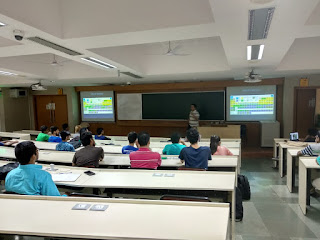Research Talks 1.0
Research Talks 1.0
On November 2nd the DAMP team organized an informal presentation by Prof. Varun Bhalerao and Prof. Mithun Mitra, who explained their fields of research and the general work they’re engaged in. Prof. Bhalerao works on instrumentation development and operation for ground based as well as satellite telescopes. His talk focused on neutron star collisions and their observation across multiple spectra, such as IR, optical, and gravitational. Moving from the astronomical to the microscopic, Prof. Mitra spoke on how people from non biological fields contribute to the life sciences. Together it was a great introduction to the interdisciplinary work done in the department.
Prof. Bhalerao began with a beautiful time lapse video of the GROWTH telescope at Ladakh. He moved on to the importance of studying neutron star collisions, which are primary sources for the synthesis of heavy metals and provided insights to the equation of state to the neutron star. A considerable section of the talk focused on how the Global Relay of Observatories Watching Transients Happen(GROWTH) works in conjunction with LIGO to cover the sky to detect neutron star collision. Prof. Bhalerao also spoke about the new proposals for satellites put forth by the institute that are to be constructed at the campus, Daksha, which will be 10x more sensitive in gamma ray region than contemporary satellite telescopes.
Prof. Mitra addressed perhaps the most persistent question in the mind of a freshie reluctantly waking up for his 8:30AM BB101 tutorial, “Why am I as an engineer/mathematician/physicist studying biology?” Paraphrasing his answer, Prof. Mitra stated how the field of biology with the advent of better experimental techniques has transformed to a data driven science from a merely descriptive one. He went on to cite how polymer physics and non-equilibrium statistical mechanics explains the motion of molecular motors and the arrangement of DNA in the cellular nucleus into chromosomal territories.
The talk was a successful start and did accomplish its primary objective of bringing faculty and students together in a less formal setting to discuss science and research openly. Here’s hoping further talks have a similar outcome.
Here are a few glimpses of the event.




Comments
Post a Comment